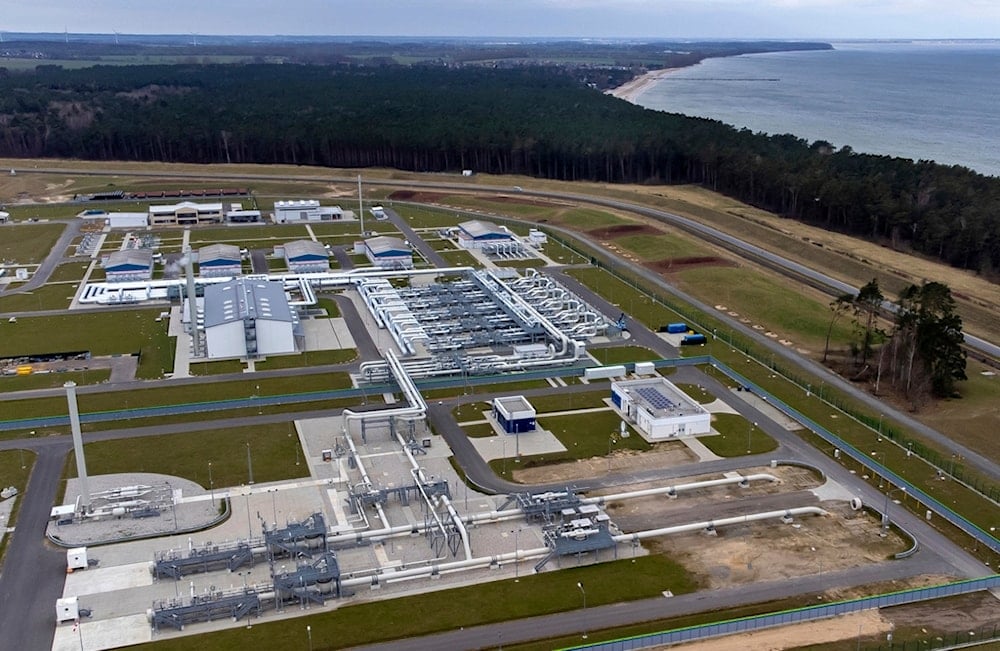Europe struggles with costly energy shift amid crisis fallout: NYT
Prior to 2022, Russian gas supplied about 20% of Europe's energy needs.
-

Pipes at the landfall facilities of the 'Nord Stream 2' gas pipeline are pictured in Lubmin, northern Germany, on February 15, 2022 (AP)
The New York Times reported on Monday on Europe's shifting energy landscape following the war in Ukraine. The European Union (EU) made a strategic decision to reduce its reliance on Russian natural gas, aligning with broader efforts to weaken Moscow economically. This led to a surge in liquefied natural gas (LNG) imports from the United States and a significant expansion of renewable energy sources.
Germany now receives US LNG shipments, Spain has expanded wind power, and France has implemented energy-saving measures in government buildings. Wind and solar energy generation has grown by roughly 50% since 2021, and new nuclear projects are in development. However, Europe remains vulnerable due to its continued dependence on costly gas imports, particularly LNG, which has strained industries and households.
Reducing Russian gas imports
Prior to 2022, Russian gas supplied about 20% of Europe's energy needs. European Commission President Ursula von der Leyen remarked, "The energy appeared cheap, but it exposed us to blackmail." Gas prices surged as the EU voluntarily moved away from Russian supplies, prompting efforts to diversify sources. By 2025, Russian gas is expected to account for only 8% of Europe's imports, down from 35% in 2021, according to S&P Global Commodity Insights.
Norway is now Europe's largest gas supplier via pipelines, yet Russia remains a major LNG provider, second only to the US Improved infrastructure and energy-saving measures, such as lower thermostats and reduced industrial consumption, have helped manage supply. Anatol Feygin of Cheniere Energy noted that Europe now has "a tremendous amount of flexibility" in its energy system.
Read more: EU split over Russian gas comeback in war talks: FT
Renewables and economic struggles
Renewable energy has expanded significantly, with wind and solar surpassing fossil fuels in 2024 for the first time. Tim Gould of the International Energy Agency called this shift "a big change" driven by policy incentives.
However, high energy costs persist. Gas and electricity rates remain elevated, and further investment is needed to ensure energy stability during periods of low wind and solar output. Some industries argue that European policies have not done enough to support their transition to greener production. ArcelorMittal, Europe's largest steel company, stated that energy and market conditions "have not moved in a favorable direction."
LNG market pressures and price volatility
Europe competes with China and South Korea for LNG, keeping prices high. In January, US LNG tankers originally destined for Asia changed course to Europe, where profits were higher. Former US energy envoy David Goldwyn acknowledged Europe's progress but cautioned, "When the weather turns cold and competition from Asia for LNG increases, the situation looks more challenging."
While Russian pipeline gas imports have dropped, Europe continues to buy Russian LNG. Some analysts suggest that future negotiations with Moscow over Ukraine could involve renewed Russian gas exports, potentially harming US energy exporters.
Read more: Trump tells EU to buy US oil, gas or face tariffs: Financial Times
Economic and social consequences
High energy prices have led to inflation, factory closures, and job losses. BASF is scaling back operations in Germany while expanding in China, where energy is cheaper. Norwegian fertilizer giant Yara is shutting ammonia production in Belgium, cutting jobs.
Energy poverty is rising, with nearly 10% of Europeans struggling to heat their homes. "We've created a state of energy precariousness," said Niki Vouzas of the National Federation of Rural Families in France.
While gas prices have fallen from 2022 highs, they remain above pre-war levels. "We are past peak crisis," said Michael Stoppard of S&P Global Commodity Insights. "But we are not out of the woods."

 4 Min Read
4 Min Read








